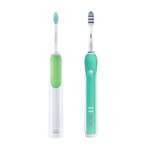Oscillating vs Sonic Toothbrushes
Written by Advice Team on February 10, 2016
One question we are asked more than any other is this one - which toothbrush technology is the best; Oral-B’s oscillating technology or Philips Sonicare toothbrush collection?
Many clinical studies have proven that electric toothbrushes hold an advantage over manual brushing, especially when it comes to removing plaque, but there is no clear leader when it comes to the technology. In some trials the oscillating-rotating power brush provided slightly improved reductions in gingivitis and increased plaque removal when compared to the sonic brush but this is not necessarily seen across the board and there are varying and conflicting results among individual studies.
Both Oral-B/Braun and Philips have been around for more than 30 years and are recognised as the industry leaders in modern toothbrush technology but as far as our experience tells us, the choice between Oral-B oscillating technology or Philips Sonicare comes down to a matter of personal preference. If you are new to electric toothbrushing and are unsure which type to choose here’s a bit of an overview into the two main players.
Oscillating Rotary Toothbrushes Oscillating rotary toothbrushes have bristles which are usually arranged in a circle on a head which oscillates back and forth. Other technologies have been incorporated over the years, such as ‘3-D’ by Braun which combines oscillating, vibrating, and pulsating brush head movements to remove more plaque than a single head motion.
Oscillating toothbrushes generally have a brushing action ranging from 2500 to 7500 rotations per minute as opposed to roughly 300 per minute when using a manual toothbrush. This is what allows the electric oscillating toothbrush to remove much more plaque, although a downside reported by some people is that this can feel a little too harsh for them on their gums.
Rotary, oscillating and pulsating brushes are a relatively new addition to Braun’s products and with this addition of the pulsating motion can now create movements of up to 40,000 pulses per minute on the higher end models. These high frequency movements create a ‘non-contact’ cleaning action, just like a regular sonic toothbrush which can agitate the fluids in the mouth and clean below the gum-line where the bristles can’t reach so the lines between technologies are now starting to blur.
Sonic Toothbrushes Like oscillating rotary toothbrushes sonic toothbrushes have rotating and oscillating features to remove plaque, but they also benefit from moving a lot faster. Sonic brushes have an estimated 30,000 brushes per minute, compared to a maximum of 7500 rotations per minute with a standard oscillating toothbrush. This extra-fast movement in theory means more plaque removal.
In addition sonic toothbrushes also employ another method which is to use a technique called ‘fluid dynamics’. This is a secondary cleaning action which reaches far beyond what a mechanical scrubbing motion can achieve. The high frequency and intense vibrational speed of the bristles ‘agitate’ the water and other fluids in the mouth to the extent that its reach extends beyond the actual brush contact points for about 1/8 inch. This means the brushing covers more surface area, even beyond where the bristles can physically reach such as under the gum line and between teeth and bridge work.
Because of the added coverage and significantly higher brushing speed, it’s hard not to to see sonic brushes as offering an added benefit. However some people have reported that they don’t like the sensation of the sonic technology.
So in the end we have no clear winner, but rather two very proficient options; the high end Braun Oral-B toothbrushes are now approaching the speed of the Philips Sonicare brushes and the decision will have to come down to the individual person on which brushing motion they prefer. As with all our products, if you have any further questions, please don’t hesitate to ask and we’ll be more than happy to offer whatever assistance we can.